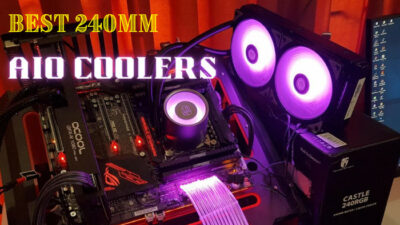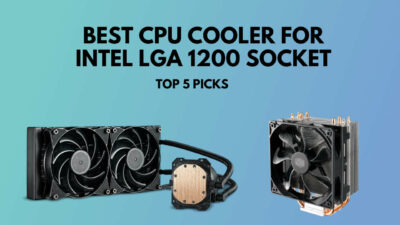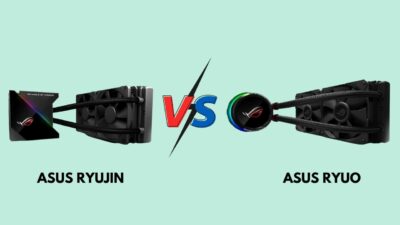On an ITX build, you have very limited space for installing a CPU cooler. Plus, add in the cramped case, and there is every chance of heat building up that can slow down your processor.
So you must use a cooler that can push out the hot air effectively and keeps your processor cool even after long periods of use. And after testing, we found these four coolers that are worthy of your hard-earned cash.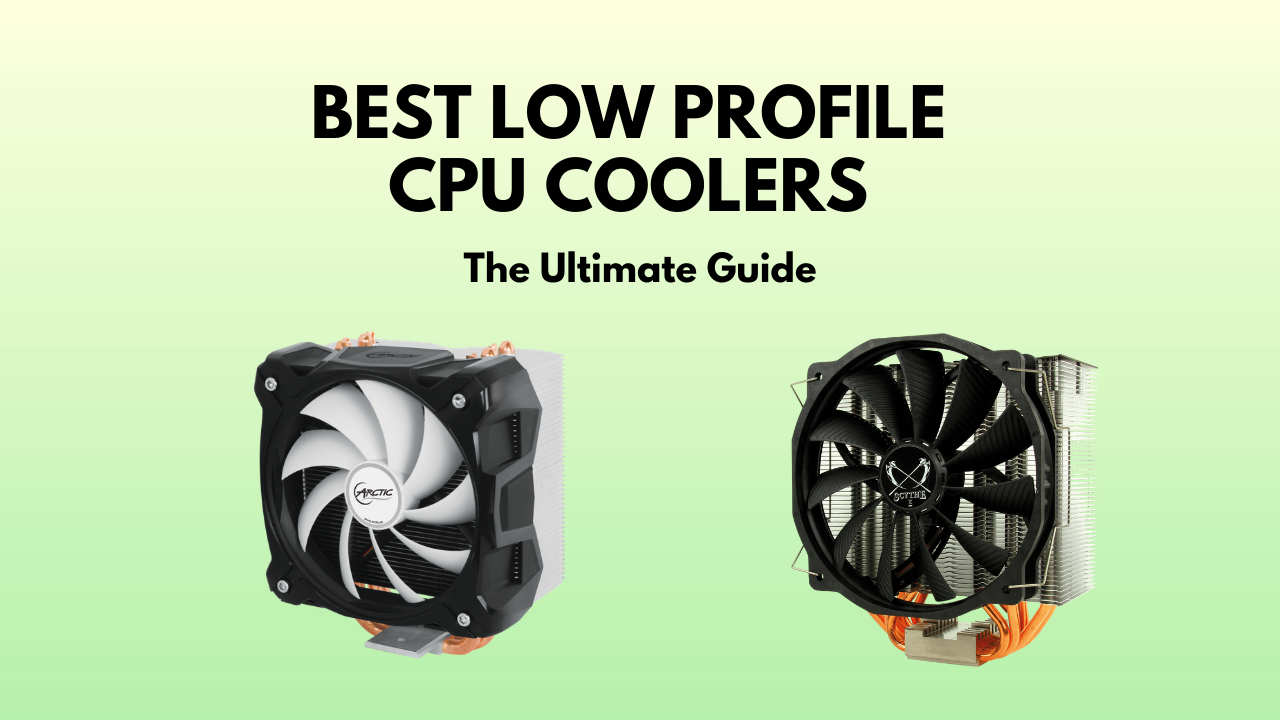
If you are in a hurry: The Noctua NH-L12 posted some very good temperatures and hence got the award for best performing low profile CPU cooler in our testing.
Best Low Profile CPU Coolers
| Model | Award | Height |
|---|---|---|
| ID-Cooling IS 55 ARGB | Best in Budget | 57 mm |
| Noctua NH-L9A | Best Compact Low Profile | 37 mm |
| Noctua NH-L12 Ghost S1 | Best Performance | 66 mm |
| DeepCool LS320 120mm | Best Low-Profile Liquid Cooler | 57 mm |
1. Best in Budget: ID-Cooling IS 55
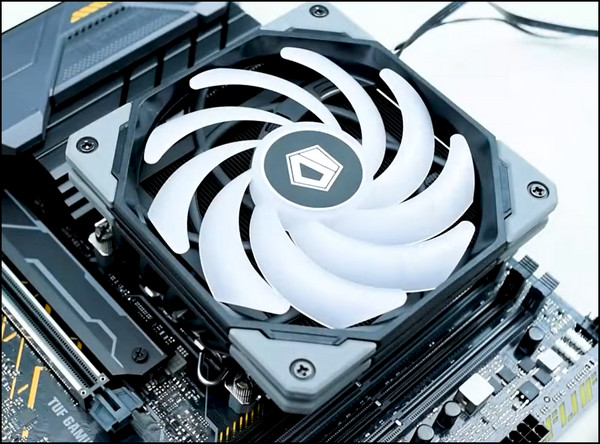
SPECIFICATIONS
Dimensions: 120 by 120 by 55 mm | Fans: 1x 120 mm PWM | Fan Speed: 500-2000 RPM | TDP: 125 W | Heat Pipe: 5 | Ram Clearance: 40 mm | Supported sockets: Intel LGA1700, LGA1200, LGA115x and AMD AM4 & AM5
- »Large heatsink than the previous model.
- »Easy installation.
- »Great cooling.
- »Affordable.
- »Low clearance with RAM and motherboard heatsink.
Why We Picked It
Starting off this list, we have the ID-Cooling IS 55. Coming at under 40 dollars, this is one of the best affordable CPU coolers you can buy.
It is compatible with the latest Intel 13th Gen and AMD AM5 processors, which is great. And it uses the same backplate as what AMD uses, so another point to ID-Cooling. And yes, the cooler is pretty straightforward to install.
You get a large heatsink than before, which weighs 450g. Six heat pipes are included, which dissipate the heat evenly. You also get a copper base, which is a nice addition.
The large heatsink and the 120 m fans ace our tests when it comes to cooling. We tested the cooler by maxing out the CPU, targeting loads at 65 and 95 watts. The results surprised us, honestly. The temperatures were 62 and 82 degrees, respectively. As for the noise levels, we measured a quiet 38 decibels. These are excellent results for a cooler that does not cost as much.
You also get ARGB support here, which is fantastic. This particular cooler uses a 4-pin PWM connector.
Our only gripes lie in the size of the cooler. Due to the large heatsink, you get a very small RAM clearance of 40 mm. And if you have a large motherboard IO heatsink, that can cause problems too. So, better check out the dimensions to stay on the safe side.
Who It’s For
- Has the room for a large cooler on their ITX case.
- Want ARGB colors.
- Do not want to spend a lot on the CPU cooler.
What We Liked Most
- The low temperatures and noise.
- Great Pricing.
- Customize RGB colors.
What We Didn’t Like
- It may not fit in all cases.
Verdict
With great cooling and without making any noticeable noise, the ID-Cooling IS 55 is the best budget cooler which performs very close to some of the more expensive models in this list. And that makes it the best choice for anyone looking for a low-profile CPU cooler on a constrained budget.
2. Best Compact Low Profile: Noctua NH-L9A
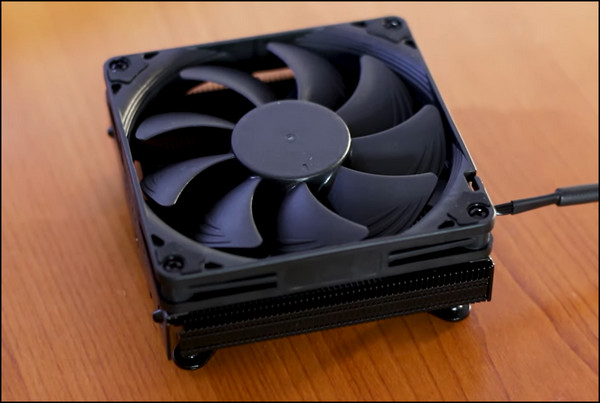
SPECIFICATIONS
Dimensions: 114 by 92 by 37 mm | Fans: 1x 92 mm NF-A9X 14 | Fan Speed: 500-2200 RPM | TDP (NSPR): 61 W | Heat Pipe: 1 | Ram Clearance: 100% Compliant | Supported sockets: AMD AM4 | RGB Support: No
- »Very compact. Compatibility with most cases.
- »Good temperatures for its size.
- »Near silent operation.
- »Expensive compared to the competition.
Why We Picked It
The Noctua L9a is the smallest cooler on this list. Its diminutive size means that it is sure to fit even in the smallest of cases. This is due to a clearance of 37mm, which is almost half of some of the tallest options.
There are different versions for both Intel and AMD. Also, you get the mounting brackets and the excellent-performing Noctua NT-H1 thermal paste included in the box.
The fan is a 90 mm NF-A9x 14. You get PWM control, plus it is super quiet.
To test this, we ran a stress test at 65 W loads. The maximum temperature was recorded at 67 degrees. The noise during this time was a whisper-quiet 38 decibels. If you run the fan at the max speeds, then the average temps drop down below 60 degrees. These are excellent results considering the very small heatsink that you get.
We even tried gaming targeting a 95W thermal headroom. The temperatures were a little higher at 69 degrees, with the sound levels never exceeding 38 decibels.
The best thing about Noctua coolers is six years warranty. Plus, there are numerous add-ons available that make this cooler highly customizable.
We have selected the brown and beige color scheme, which may not be for everyone. There is a matt black option present, but it costs ten dollars more. Unfortunately, there is no RGB option present here.
Who It’s For
- Those who want a good cooler in the smallest form factor.
- Want an absolutely silent fan on a CPU cooler.
What We Liked Most
- Near silent fan during full load.
- Good temperatures.
- Great build quality.
- Fit with even the smallest of cases.
What We Didn’t Like
- Still costs a premium.
- No RGB option
Verdict
The Noctua L9a is the best small form factor cooler that we have tested. You get great temps and a silent fan which are paramount for a small form factor PC. In short, we really this cooler for its useability & compatibility.
3. Best High Performance: Noctua NH-L12 Ghost S1
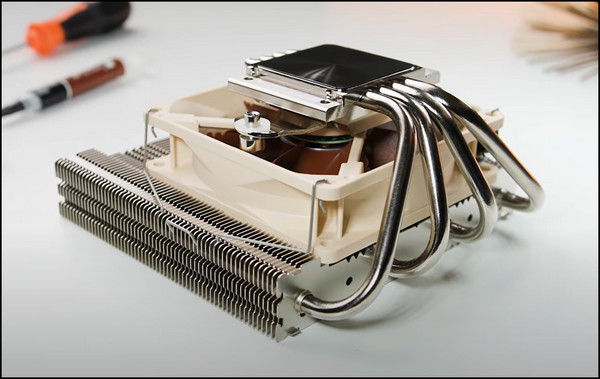
SPECIFICATIONS
Dimensions: 146 by 128 by 86 mm | Fans: 1x 120 mm NF-A12x15 | Fan Speed: 300-1600 RPM | TDP (NSPR): 78 W | Heat Pipe: 4 | Ram Clearance: 45 mm | Supported sockets: Intel LGA1700, LGA1200, LGA115x, LGA 2011 and AMD AM4, AM5 | RGB Support: No
- »Best cooling from a low-profile cooler.
- »Low noise.
- »More space for memory.
- »Clearance issues with small cases.
Why We Picked It
The Noctua NH-L12 Ghost is the pinnacle of low-profile liquid coolers. It sports the largest heatsink among all the coolers included here, with a length of 150 mm. And if you noticed, yes it has an unusual design with the heatsink placed on top of the fan. There are four heat pipes that dissipate the heat efficiently.
The fan you get is a 92 mm NF-B9. It is actually quite smaller than the overall size of the heatsink, which gives you another benefit – RAM clearance. You get 48 mm of space to fit in your memory module.
As usual, AIDA 64 was how we ran the stress testing, targeting 65 and 95 watts. The latter is quite higher than what Noctua rates this cooler for. But that can really reveal the worst-case scenarios during a sustained load.
At 65 watts, the temperatures were at an average of 61 degrees. When we bumped up the power limit, we got 85 degrees. That was not a low temperature, but mind you that you won’t be running your CPU at that power limit all the time.
While running a game set with a 95W power limit, we only got 62 degrees which was great. This is more in line with what you will encounter on a daily basis if you plan on gaming.
The noise levels never exceeded 40 decibels which just showcases how great the included fans are at their work.
Coming to compatibility, you have support for Intel’s 13th gen and AMD AM5 processors. It also supports a wide range of older ones with the right mounting bracket, which is included in the packaging. Noctua also provides an NT-H2 thermal paste, which is another top-rated product.
Who It’s For
- You want the best-performing cooler for your ITX build.
- The cooler must operate silently.
- Have a small case.
What We Liked Most
- Chart-topping performance for a low-profile air cooler.
- Great acoustics.
- Large heatsink.
What We Didn’t Like
- Needs larger clearance than other low-profile coolers.
Verdict
The Noctua NH-L12 performs admirably even at higher power limits while keeping noise near silent levels. This is the best-performing low-profile air cooler, giving tough competition to the full-sized ones.
4. Best Low-Profile Liquid Cooler: DeepCool LS320
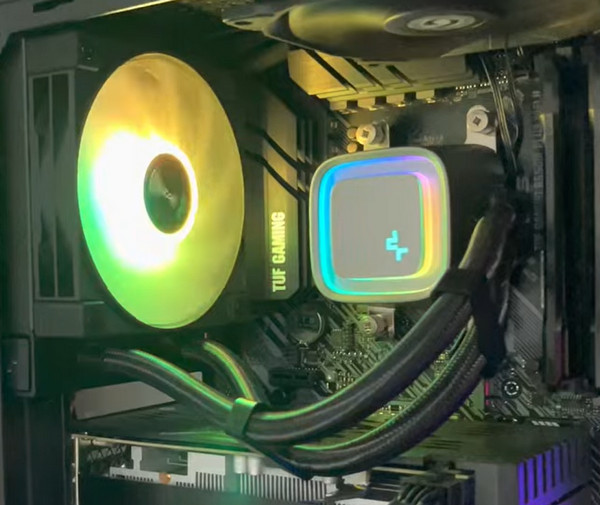
SPECIFICATIONS
Radiator: 159 by 120 by 27 mm | Pump: 86 by 74 by 57 mm | Fans: 1 x 120 mm FC 120 | Fan Speed: 2250 RPM | TDP: 220 W | Fin Density: 24 per inch | Ram Clearance: 100% compliant | Supported sockets: Intel LGA1700, LGA1200, LGA115x and AMD AM4, AM5 | RGB Support: Yes
- »Great cooling, which is similar to high-end air coolers.
- »RGB support.
- »Replaceable pump covers.
- »No clearance issues with memory.
- »Higher temps at loads greater than 150 W.
Why We Picked It
You may wonder why we included an AIO cooler for this comparison. Well, this particular unit has got a radiator with only a thickness of 27 mm which makes it great for easy installation even on smaller cases. The pump, too, has a height of 57 mm which provides clearance for your case.
The pump has a custom design made by Deepcool, which improves its performance compared to other 120 mm coolers. Also, you can change the faceplate and use your own stickers, which gives Deepcool another point in this round.
Now, since this is a water-cooled unit, this will perform better than any air-cooled one. But as it only comes with a single 120 mm fan, that can limit how much heat it can dissipate.
Let’s see how it performs. When running sustained loads at 95 watts, the Deepcool LS320 outperforms the gold standard Noctua D15 getting only 57 degrees warmer. Upping the power limits to 125 watts got us 72 degrees. When we got to 150 W, the cooler started to show its limits by getting an average of 84 degrees.
Overall, the noise was considerably more than what we got with any air coolers mentioned here, considering some performed at near-silent levels. But this is to be expected. Water cooling needs ramped-up fans to bring temperatures down to a comparable level.
But the best thing about the Deepcool is that it is possible to cool down a much beefier processor with this AIO without toasting it.
As for the goodies, you get ARGB support with both the pump and the fan. Deepcool does not provide dedicated software to control these. For that, you can use any open-sourced app.
Who It’s For
- You want the best cooling possible for an ITX build.
- Has a powerful CPU in a small case.
- Need RGB support.
What We Liked Most
- Great cooling compared to low-profile coolers.
- Nice pump design. The pump motors work really well too.
- Compact radiator.
- User-customizable face plate.
What We Didn’t Like
- Expensive than the low-profile coolers.
- Starts to struggle at really higher loads.
Verdict
The Deepcool LS 320 can be a great choice for you if you want to opt for an AIO cooler for an ITX build. You get more cooling and thermal headroom compared to the smaller, low-profile coolers. It comes at a competitive price too.
How We Chose The Best Low-Profile Cooler
Before you make the final purchasing decision, there are some things you need to look for when buying a low-profile cooler. These are technically the specs that you would look at in each product, and that is how you would distinguish one from the other.
Height
For an SFF build, the height of the cooler is extremely important. If the cooler does not have the required clearance, you would likely have to rock a case with an open side panel.
Typically the height is less than 70 mm for low-profile coolers. But if your case has the room, then you can fit a larger one into your build.
Socket
Not all coolers will support every processor on the planet. You have to look at which sockets are supported by it. Brands such as Noctua have a history of supporting their coolers or newer processors. They make newer mounting brackets so that older coolers are compatible with them. But still, do check if your processor is supported by a certain cooler.
Noise
Noise is another critical aspect of an ITX build. People often build these HTPCs, which need to be super quiet. And most low-profile coolers focus on operating silently. Fan speeds play an important part in this. Do note what RPM each fan can provide to get an idea. Look for a fan that stays below 40 decibels when running at full speeds.
RGB Support
Maybe you want the CPU coolers to have fancy RGB colors. Then you would want to look for ones that come with ARGB support. The included software is also a factor when deciding this. Because not all manufacturers bundle their products with good software, some fans skimp this feature entirely.
Frequently Asked Questions
Are low-profile CPU coolers worth it?
Yes, they are. Considering the small form factor, they have significant cooling prowess. Most of them can easily cool a CPU upto a 100 watts, which is more than enough for low-profile builds.
Are low-profile CPU coolers better than stock coolers?
Stock coolers can cool a CPU up to 100 watts, but these are not good at dissipating heat. A third-party cooler can significantly reduce the temperature by at least 10-15 degrees while remaining silent.
Can I use a low-profile cooler with an overclocked CPU?
This is entirely dependent on how much overclock you are using and what CPUs are being used. Normally any overclock will result in a significant amount of heat which is much higher than a processor’s rated TDP. If the cooler is within that range, then it can cool your overclocked CPU. But it is advised that you either go for a full-size CPU cooler or an AIO unit when using an overclocked CPU.
Are low-profile CPU coolers silent?
Most of them are, actually. Because of their diminutive size, they are mostly used on small form factor PCs. So the fans are tuned so that they do not make much noise. Low-profile coolers normally operate under 40 dB, even under full load.

